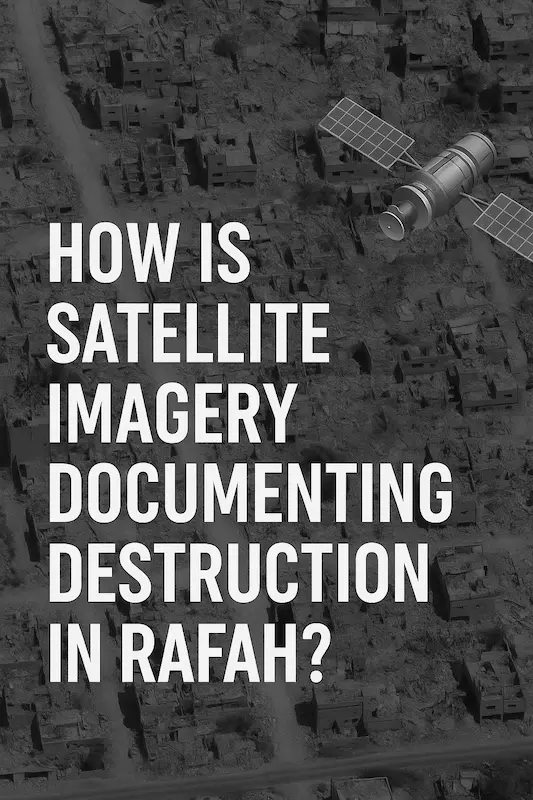Recent satellite imagery reveals the extensive damage and devastation inflicted upon Rafah, a city located in the Gaza Strip. As the conflict between Hamas and Israeli forces escalates, the humanitarian crisis has reached alarming levels, with countless residents displaced and in dire need of assistance.
The ongoing military operations have resulted in a significant loss of infrastructure and human lives, which is starkly documented through satellite imagery. This technology not only captures the physical destruction but also highlights the urgent need for humanitarian aid and international intervention.
How is satellite imagery documenting destruction in Rafah?

Satellite imagery serves as a crucial tool in understanding the scale of destruction in Rafah. Using high-resolution images, analysts can track changes in the landscape over time. This allows for detailed assessments of the damage inflicted by military actions. Recent analyses indicate that nearly 80% of the buildings in Rafah have been destroyed, a shocking statistic that highlights the severity of the conflict.
Organizations like Bellingcat utilize these images to conduct open-source investigations, piecing together information that is often hard to verify due to the media blockade in the region. This method has been vital in corroborating reports of destruction and human rights violations.
Moreover, these images reveal not only the destruction of buildings but also the displacement of residents. As families flee their homes, the satellite data captures the changing demographics and the growing number of refugees in the area.
What are the impacts of Israeli military actions in Rafah?
Infrastructure Destruction
The impacts of Israeli military actions in Rafah are multifaceted, affecting both the infrastructure and the civilian population. The destruction of buildings in Rafah has led to severe housing shortages, pushing many families into overcrowded shelters or makeshift camps.
Human Casualties
Furthermore, the ongoing conflict has resulted in significant casualties, with thousands of residents suffering from injuries or losing their lives. The psychological toll on the survivors is profound, as they grapple with the loss of loved ones and the destruction of their communities.
Humanitarian Crisis
The humanitarian crisis in Rafah is exacerbated by the blockade imposed by Israeli forces, restricting access to essential supplies like food, water, and medical aid. This has led to widespread malnutrition and health crises among the population.
How many buildings have been destroyed in Rafah according to satellite images?
According to satellite images, a staggering 80% of buildings in Rafah have been reported destroyed. This figure encapsulates the extensive damage inflicted during military operations, leaving vast areas of the city in ruins.
The destruction spans residential areas, schools, and hospitals, crippling the city’s infrastructure. This comprehensive loss not only disrupts daily life but also hinders efforts to provide humanitarian assistance to those in need.
As satellite imagery continues to document these changes, it becomes increasingly apparent that the need for international aid and intervention is urgent. Without immediate action, the situation in Rafah is likely to worsen, leading to further loss of life and suffering.
What is the humanitarian crisis like for residents of Rafah?
The humanitarian crisis in Rafah is dire, with the majority of the population facing extreme challenges. Access to clean water, food, and medical care has been severely restricted due to the ongoing conflict and blockade.
Many families are left without adequate shelter, leading to overcrowding in temporary accommodations. The living conditions are often unsanitary, increasing the risk of disease outbreaks. Reports indicate that over 1 million refugees have fled the area, contributing to the crisis.
The psychological effects of this situation cannot be overstated, as countless individuals struggle with trauma and grief. Children, in particular, are vulnerable, facing disruptions in their education and stability.
How are refugees in Rafah coping with the ongoing conflict?
Refugees in Rafah are employing various strategies to cope with the ongoing conflict and its repercussions. Many are relying on the support of humanitarian organizations that have stepped in to provide essential services, though their reach is often limited due to the blockade.
Community solidarity plays a crucial role, as families band together to share resources and support one another in these trying times. However, the continuous instability makes it difficult for refugees to plan for the future, leading to a pervasive sense of uncertainty.
Education has also suffered greatly, with many children unable to attend school due to the destruction of facilities. Community leaders are working tirelessly to create makeshift learning environments to ensure that education continues, albeit in a limited capacity.
What are the international reactions to the situation in Rafah?
International reactions to the situation in Rafah have varied, with numerous organizations and governments calling for an end to hostilities and the urgent provision of humanitarian aid. The United Nations has repeatedly emphasized the need for immediate action to address the humanitarian crisis.
Accusations of human rights violations have also emerged, with various human rights advocates urging investigations into the actions of the Israeli Defense Forces during military operations. Genocide accusations against Israel have surfaced, demanding accountability for the loss of civilian life and destruction of communities.
Despite these calls for intervention, the international community’s response has been mixed, often hampered by political complexities and differing national interests. As a result, many residents of Rafah continue to suffer in silence, waiting for the relief that seems distant.
How do satellite images reflect the current conditions in Rafah?
Satellite images provide a stark visualization of the current conditions in Rafah, capturing the extensive destruction and its impact on the population. These images reveal not only the physical damage but also the shifts in demographics as residents flee the area.
Analysts and researchers utilize these images to highlight the urgent need for humanitarian assistance, showcasing the devastated landscape that once housed vibrant communities. The data serves as a critical tool in advocating for international action to address the crisis.
As satellite imagery continues to document changes in Rafah, it sheds light on the ongoing struggles of the residents. The visual evidence of destruction can often evoke a stronger response from the international community, emphasizing the reality of the humanitarian crisis unfolding.
Related questions about the situation in Rafah
How does satellite imagery show destruction in Rafah?
Satellite imagery shows destruction in Rafah by capturing high-resolution images that detail the devastation inflicted on the city. Analysts can track changes over time, making it possible to assess the extent of building destruction and the displacement of residents.
This imagery highlights key areas of concern, such as critical infrastructure loss, and is instrumental in raising awareness about the humanitarian crisis. The ability to visualize the damage helps organizations advocate for necessary international interventions.
What percentage of Rafah has been destroyed?
According to recent satellite analyses, approximately 80% of Rafah has been destroyed due to military actions. This staggering percentage underscores the scale of the devastation and the urgent need for humanitarian relief efforts.
The destruction affects not only residential buildings but also schools and healthcare facilities, severely impacting the daily lives of residents and increasing the challenges faced by aid organizations.
What are the living conditions like for displaced residents in Rafah?
Living conditions for displaced residents in Rafah are dire, with many lacking access to basic necessities. The overcrowded shelters they inhabit provide little relief from the harsh realities of the ongoing conflict.
Many families face food shortages and inadequate sanitation, contributing to health risks and a decline in their overall well-being. The psychological toll of displacement also weighs heavily on individuals, especially children.
What actions are the international community taking regarding the situation in Rafah?
The international community has expressed concern regarding the situation in Rafah, with various organizations advocating for humanitarian aid and an end to hostilities. Efforts by the United Nations and other NGOs focus on providing relief to the affected population.
However, political complexities often hinder effective responses, leading to a gap between the needs on the ground and the actions taken. Continued advocacy is vital to ensure that the plight of Rafah residents does not go unnoticed.
How have recent conflicts affected the population of Rafah?
Recent conflicts have drastically affected the population of Rafah, resulting in widespread casualties and displacement. The destruction of homes and infrastructure has left thousands without shelter, exacerbating the already dire humanitarian crisis.
As refugees flee the area, the local population faces uncertainties regarding their future. The psychological impact of the conflict, alongside the physical destruction, creates a compound effect that will take years to recover from.




